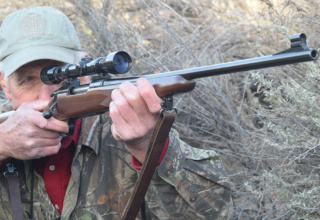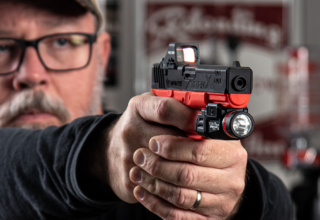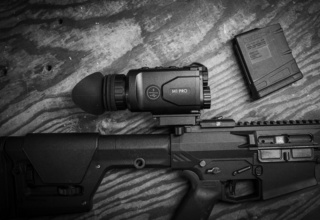Expensive, high-tech ammo options multiply. What about affordable loads for ordinary deer?
by Wayne van Zwoll
You don’t know its G7 ballistic coefficient, its ogive in calibers, or when it goes sub-sonic. What matters to you is that your bullet fits your rifle’s bore, flies to the sight, and has the moxy to kill deer. Like the bullet that tumbled a deer for me 50 years ago. Announced in 1961, Winchester’s Power-Point is still available. In fact, it appears in 45 factory loads, .223 (64 grains) to .338 Magnum (200 grains). A simple cup-and-core bullet, the Power-Point is like many softpoints of its day: a lead core in a gilding metal (95-5 copper-zinc) jacket. It’s designed to expand in common game (deer) at ordinary impact speeds (1,800 to 3,000 fps) and retain the integrity and energy to cut a lethal wound channel through vitals.

Power-Points are versatile, upsetting easily between deer ribs but punching through heavier game. An elk quartering away from me took a Power-Point mid-rib. It wound up in the off-shoulder, double its original diameter, having pierced the heart en route. Other bullets might have retained more weight, but weight shed during penetration isn’t all wasted. As shrapnel, it destroys tissue, most of that in the boiler.

Before the Power-Point, Remington’s Core-Lokt all but defined the ideal deer bullet. Introduced in 1939, it features a mid-jacket “crimp” that pinches the core to prevent separation during upset. Like its Winchester counterpart, it has been offered in pointed and round-nose form, depending on the cartridge. It has often impressed me. Once on a northern mountain, a mule deer heavy in body and antler lunged away into snow-laden conifers. A 250-grain Core-Lokt from my .35 Whelen entered its flank, exiting the neck to knock a chunk from a burly antler base.

Bullet-maker Joyce Hornady supplied hunting bullets to handloaders for over a decade before he started loading ammunition in 1964. His first Frontier loads had Hornady Spire Point bullets in recycled cases. In ’65 he began skiving bullet jackets at the nose to start and control upset. Inner-belted InterLock softpoints followed in 1977. The Frontier loadings later gave way to Hornady’s Custom ammunition, with its greater array of bullet options. The American Whitetail line arrived in 2013 for 10 popular cartridges. Now it comprises 18 loads, all with InterLock bullets.

Federal has served deer hunters since it began loading commercial centerfire ammunition in 1963. Its Power-Shok softpoint hails from the Hi-Shok bullet of that era. A growing family of game bullets now features missiles from various industry brands. Still, Federal declares, the Power-Shok is “available in the widest selection of loads.” Also for the general hunting market is the company’s Fusion bullet, fielded in 2005. It features “a bonded lead core with a copper jacket applied through an electroplating process.” The Fusion roster now includes the .300 WSM and .450 Bushmaster. Bullets made by this process appear, too, in Federal HammerDown ammunition for traditional lever rifles.
That’s really all you need to know about softnose ammunition for deer. You can spend more for boutique loads with specialty bullets. But why?

Far from dead, the aging softnose is the defining component of several top-selling factory loads. Some are new. Recently, Nosler announced its Whitetail Country series of deer cartridges. A straight-case duo features Nosler Straight-Wall bullets, 180-grain for the .350 Legend, 300-grain for the .45-70. These flat-points are designed to open readily at low impact velocities. But they resist fragmentation. In Nosler trials, a bullet at near-muzzle-speed impact (2,100 fps) kept 90 percent of its mass after almost pancaking. But 50-yard penetration in ballistic gelatin reached 18 inches. At a 200-yard impact velocity of 1,500-fps, another .350 Whitetail Country bullet also retained 90 percent of its weight. It produced double-diameter upset and cut a 25-inch furrow through gelatin.
A half-dozen Whitetail Country offerings have Nosler Solid Base bullets in bottleneck cases: 6.5 Cm (140-grain), .270 (130-grain), 7mm-08 (140-grain), .30-30 (150-grain), .308 (165-grain), and .30-06 (165-grain). Here’s how the 140-grain 6.5 Cm bullet flies, and how it retains its weight in ballistic gelatin:
Velocities and weight retention, 6.5 Creedmoor, 140-grain Solid Base, Whitetail Country load
- Printed velocity on box: 2,650 fps (muzzle); 2,409 fps (100 yds.); 1,970 fps (400 yds.)
- Weight retention (percent, in gelatin): 64 (muzzle); 74 (100 yds.); 99 (400 yds.)
Penetration in Nosler’s tests was remarkably uniform downrange: 30 inches at 50 yards, 32 at 400.

To check velocities provided on Whitetail Country boxes, I clocked 6.5 Cm, 7mm08 and .308 loads with my Garmin Xero 1 Doppler radar chronograph. Herewith the results:
Chronographed velocities of .308, 6.5 Cm and 7mm-08 Nosler Whitetail Country loads
- Printed velocity on box: 2,800 fps (.308, 19-in. barrel); 2,650 fps (6.5 Cm, 22-in. barrel); 2,825 fps (7mm-08, 24-in. barrel)
- Chronographed velocity: 2,691 fps (.308, 19-in. barrel); 2,657 fps (6.5 Cm, 22-in. barrel); 2,857 fps (7mm-08, 24-in. barrel)
I used barrels of different lengths to see how their chronographed velocities compared with those from the 24-inch barrels commonly used to get chart data for these cartridges. Velocities from my 7mm-08’s 24-inch barrel topped Nosler’s, and those from my 22-inch 6.5 Cm barrel edged chart numbers. The 5-inch disparity in length between the .308 lab barrel and my Sauer 505’s exacted a price in bullet speed. But that 109-fps dip is less than I expected. During my hurried range session to beat the weather, 6.5Cm and .308 loads printed three-shot groups nudging a minute of angle.

Is Nosler’s new ammunition — and that of competitors using softnose bullets in popular deer loads — affordable? Depends on how old you are. Prices of hunting ammo have vaulted over the last decade. My first box of 180-grain Winchester Power-Points in .303 British cost $5, same as a Michigan resident deer license then. If “affordable” takes you that far back, current stickers may bring on the vapors. (That .303 load now sells for $50 to $57). At $35, Nosler’s Whitetail Country retails for a little over half the price of “long-range” and other specialty loads for the same cartridges.
In my youth, every deer camp had a patriarch who routinely hauled big bucks from the bush but after countless Novembers was still tapping his original dog-eared box of .32-40s. “With keerful aim and a good load, one shot oughta be aplenty to put venison on the sled.” In those days, a 25-cent cartridge was to be used thoughtfully.

Of course, for even one shot, you must have a deer in front of your sights. Last fall, it seemed my lot to roam hinterlands unrewarded. Deer and elk made the occasional appearance, but most were young animals. I’m not lucky enough to be fussy about antlers; still, maturity matters. Why kill a buck or a bull not yet old enough to have endured blizzards, enjoyed spring romps in sunny meadows, or reveled in rut as a stud big enough to have his way? Taking a scythe to youth grows ever more distasteful as I age. So, too, the premature snatching of antlers not yet fully formed.
So, as others pulled carcasses from hill and forest, my fortunes remained grim. No matter where I went, it was the wrong place — though some game fell nearby. One truly big whitetail stared up from its bed as a novice fumbled to crank his scope off 20-power for the 40-yard shot. I heard the bullet’s impact and helped the young man field-dress his prize.
Later, in another state, I was entertained by whitetail traffic on the hem of a swamp. A couple of bucks brought the rifle to cheek. But like young wine, they held promise for another year. At last, I left my post there to still-hunt second-growth pines nearby, and hardwoods beyond. Prowling thickets holds more appeal for me than waiting in ambush. Every step opens fresh views, imposes new risks, and tests hunting skills not applied on stand. A shot still-hunting is a shot earned.

My rifle that day was borrowed. I hadn’t fired it other than to check zero. New to the crook of my arm, it nonetheless had an interesting history. So did my loads. Denied shooting, I take comfort in history.
The ammo was from Fiocchi, an Italian brand I’d known for years but never used on game. Giulio Fiocchi was a Milan banker in 1876 — an interesting year stateside, with June’s Battle of the Greasy Grass forever seared in our national memory as Custer’s Last Stand. A couple of months later, Dakota Territory lost James Butler Hickok to a cardroom ambush by Jack McCall, who slipped up behind Wild Bill to put a .45 bullet through his skull.
So, my thoughts drifted. Two white flags bounced lightly away. Does. I paused and glassed farther into ridgeline oaks. Sun glinted on an antler in a slot 150 yards on. This buck was alert. Dismissing him, I angled up a rise on a deer trail.
Sent by the bank to collect from a company that sold black powder and muskets, Giulio Fiocchi quickly determined there was no way the loan could be repaid. But the business intrigued him. Enlisting help from his brother Giacomo, he bought it. At first, the Fiocchis focused on serving sportsmen. Then the Great War intervened. Their factory supplied ammunition to the Italian army. After recovering during the 1920s and ’30s, the enterprise was seized in WW II. Then Allied bombs reduced the plant to rubble. The family rebuilt that facility and its business after armistice, reaching across the waves in the 1950s to court the U.S. market, with support from Smith & Wesson. In 1983, Fiocchi built a factory in Missouri. It now manufactures nearly all the ammunition it sells stateside. The product line has grown steadily to include rimfire, shotshell, and centerfire rifle and pistol cartridges. Fiocchi lists eight lines of rifle ammo — target and defense as well as four categories of hunting loads.

A Fiocchi softnose was in the chamber when, at mid-day, I emerged from the oaks on a bluff that fell sharply to the swamp. Suddenly, a buck and a doe broke from cover below and dashed off through tall grass and new pines. They’d have made good their escape, had not the doe paused just shy of concealing cover. Offhand, but elbow braced on a dead limb, I pasted the crosswire on the buck’s chest as he, too, braked. My 6.5mm bullet zipped through his vitals and exited. The scramble was brief; he collapsed 30 yards on.
I don’t know that bullet’s G7 ballistic coefficient, its ogive in calibers, or when it goes subsonic. I took no remaining cartridges home so have yet to chronograph that Fiocchi load. It’s enough knowing the bullet ended my season with an aged, gray-faced buck whose scraggly 3×5 antlers were as good as they’d ever be. Fiocchi has joined my roster of game loads that have capped memorable days afield.
More on Price
The bigger the cartridge and the more complex the bullet, the more costly the ammo. So, polymer-tipped bullets hike cartridge cost. (As did Winchester’s original Silvertip, which reportedly required more than 50 steps in manufacture!) Traditional cup-and-core softnose bullets cost less to produce. But all that endure at market perform well on game, and loads that feature them remain top values.

You can buy Winchester .270 loads with Power-Point bullets for about $29 a box. The company’s tipped Deer Season XP bullet bumps price to $43. Remington .308 ammo with Core-Lokt bullets lists for about $40. Core-Lokt Tipped bullets hike MSRP to $54.
Another factor: demand. Popular loads in constant production sell for less than those with slower turnover. Winchester lists a 200-grain Power-Point load for the .35 Remington at $55. Remington Core-Lokt .35 loads fetch even more: $68, about what Remington gets for .32 Special ammo. At either factory, .30-30 cartridges cost about the same as .35s and .32s to make, but more .30-30s sell; volume helps pull retail price to a current $27. Remington Core-Lokt loads for the .257 Roberts and .300 Savage list at over $77, but perpetual demand for 180-grain .30-06 ammo holds its per-box price at $40.


















